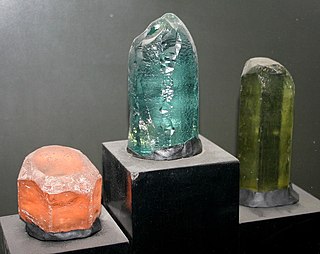
Beryl ( BERR-əl) is a mineral composed of beryllium aluminium cyclosilicate with the chemical formula Be3Al2Si6O18. Well-known varieties of beryl include emerald and aquamarine. Naturally occurring, hexagonal crystals of beryl can be up to several meters in size, but terminated crystals are relatively rare. Pure beryl is colorless, but it is frequently tinted by impurities; possible colors are green, blue, yellow, and red (the rarest). Beryl can also be black in color. It is an ore source of beryllium.
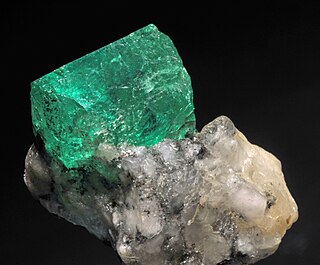
Emerald is a gemstone and a variety of the mineral beryl (Be3Al2(SiO3)6) colored green by trace amounts of chromium and/or sometimes vanadium. Beryl has a hardness of 7.5–8 on the Mohs scale. Most emeralds are highly included, so their toughness (resistance to breakage) is classified as generally poor. Emerald is a cyclosilicate.

A gemstone is a piece of mineral crystal which, in cut and polished form, is used to make jewelry or other adornments. However, certain rocks and occasionally organic materials that are not minerals are also used for jewelry and are therefore often considered to be gemstones as well. Most gemstones are hard, but some soft minerals are used in jewelry because of their luster or other physical properties that have aesthetic value. Rarity is another characteristic that lends value to a gemstone.
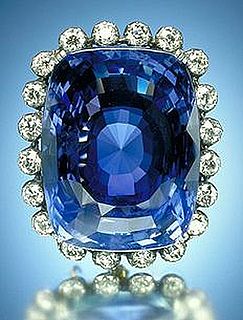
Sapphire is a precious gemstone, a variety of the mineral corundum, consisting of aluminium oxide (α-Al2O3) with trace amounts of elements such as iron, titanium, chromium, vanadium, or magnesium. It is typically blue, but natural "fancy" sapphires also occur in yellow, purple, orange, and green colors; "parti sapphires" show two or more colors. Red corundum stones also occur, but are called rubies not sapphires. Pink-colored corundum may be classified either as ruby or sapphire depending on locale. Commonly, natural sapphires are cut and polished into gemstones and worn in jewelry. They also may be created synthetically in laboratories for industrial or decorative purposes in large crystal boules. Because of the remarkable hardness of sapphires – 9 on the Mohs scale (the third hardest mineral, after diamond at 10 and moissanite at 9.5) – sapphires are also used in some non-ornamental applications, such as infrared optical components, high-durability windows, wristwatch crystals and movement bearings, and very thin electronic wafers, which are used as the insulating substrates of special-purpose solid-state electronics such as integrated circuits and GaN-based blue LEDs. Sapphire is the birthstone for September and the gem of the 45th anniversary. A sapphire jubilee occurs after 65 years.

A ruby is a pink to blood-red colored gemstone, a variety of the mineral corundum. Other varieties of gem-quality corundum are called sapphires. Ruby is one of the traditional cardinal gems, alongside amethyst, sapphire, emerald, and diamond. The word ruby comes from ruber, Latin for red. The color of a ruby is due to the element chromium.
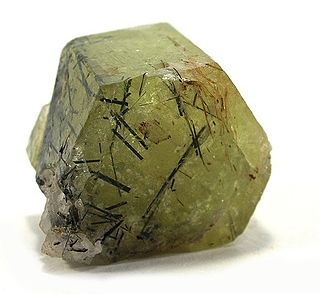
In mineralogy, an inclusion is any material that is trapped inside a mineral during its formation. In gemology, an inclusion is a characteristic enclosed within a gemstone, or reaching its surface from the interior.

The Gemological Institute of America (GIA) is a nonprofit institute dedicated to research and education in the field of gemology and the jewelry arts and based in Carlsbad, California. Founded in 1931, GIA's mission is to protect buyers and sellers of gemstones by setting and maintaining the standards used to evaluate gemstone quality. The institute does so through research, gem identification and diamond grading services and a variety of educational programs. Through its library and subject experts, GIA acts as a resource of gem and jewelry information for the trade, the public and media outlets.

Tairus is a synthetic gemstone manufacturer. It was formed in 1989 as part of Mikhail Gorbachev's perestroika initiative to establish a joint venture between the Russian Academy of Sciences and Tairus Created Gems Co Ltd. of Bangkok, Thailand. Today Tairus is a major supplier of hydrothermally grown gemstones to the jewellery industry. Later, Tairus became a privately held enterprise, operating out of its Bangkok distribution hub under the trade name Tairus, owned by Tairus Created Gems Co Ltd. of Bangkok, Thailand.
The Asian Institute of Gemological Sciences (AIGS) is a private gemological school and gemological laboratory based in Bangkok, Thailand. The AIGS was founded in 1978 and was Thailand's first educational facility devoted to the study of gemstones. The school and the laboratory are located in the Jewelry Trade Center, on Silom Road, in the heart of the gem and jewellery district of Bangkok.
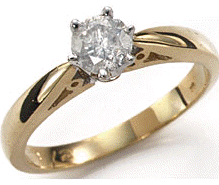
Merged content from Tiffany mount to here. See Talk:Prong setting#Merger proposal.
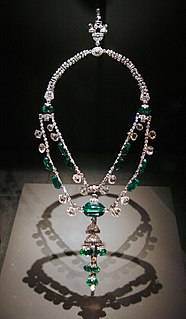
The Spanish Inquisition Necklace is a diamond and emerald-studded necklace. As of 2008, it is on display at the Smithsonian Institution in Washington, D.C., United States. It was given its name by Harry Winston, the American jeweller who acquired it from the Maharaja of Indore, and has no known connection with the historical Spanish Inquisition.

Katlang is a tehsil in the Mardan District of the Khyber Pakhtunkhwa, Pakistan. It is located approximately 19 kilometers north of Mardan. The population of Katlang was 343,144 in 2017.

The Hooker Emerald Brooch is an emerald brooch designed by Tiffany & Co. The brooch is on display in the Janet Annenberg Hooker Hall of Geology, Gems, and Minerals at the Smithsonian Institution's National Museum of Natural History in Washington D.C., United States.

Ronald Ringsrud is an emerald dealer, gemologist, and author of Emeralds, A Passionate Guide. This work draws on Ringsurd's decades of work in the emerald industry and includes a foreword written by John Koivula, the Chief Gemologist at GIA.

Emeralds are green precious gemstones that are mined in various geological settings. They are minerals in the beryl group of silicates. For more than 4,000 years, emeralds have been among the most valuable of all jewels. Colombia, located in northern South America, is the country that mines and produces the most emeralds for the global market. It is estimated that Colombia accounts for 70–90% of the world's emerald market. While commercial grade emeralds are quite plentiful, fine and extra fine quality emeralds are extremely rare. Colombian emeralds over 50 carat can cost much more than diamonds of the same size.

ICT Incorporated, operating under the trade name the Shelby Gem Factory, was a Michigan company that manufactured artificial gemstones through proprietary processes. The factory made more varieties of man-made gemstones than any other in the world. It grew artificial gems and gem simulants, including synthetic ruby and sapphire and simulated diamonds, citrine, topaz, and other birthstone substitutes, and mounted them in gold or silver jewelry.
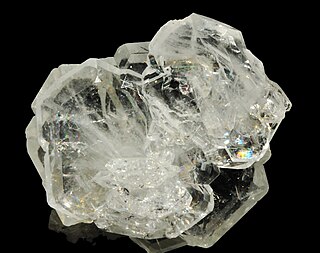
Goshenite is a colorless gem variety of beryl. It is called the mother of all gemstones because it can be transformed into other like emerald, morganite, or bixbite. Goshenite is also referred to as the purest form of beryl since there are generally no other element present in the stone. The gem is used as imitation for diamond or emerald by adding colored foil on it.

Morganite is a orange or pink gemstone and is also a variety of beryl. Morganite can be mined in countries like Brazil, Afghanistan, Mozambique, Namibia, the United States, and Madagascar.
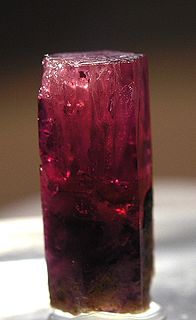
Red beryl, formerly known as bixbite and marketed as red emerald or scarlet emerald, is an extremely rare variety of beryl as well as one of the rarest minerals on Earth. The gem gets its red color from manganese ions embedded inside of beryllium aluminium cyclosilicate crystals. The color of red beryl is stable up to 1000 degrees. Red Beryl can come in various tints like strawberry, bright ruby, cherry, and orange.


















